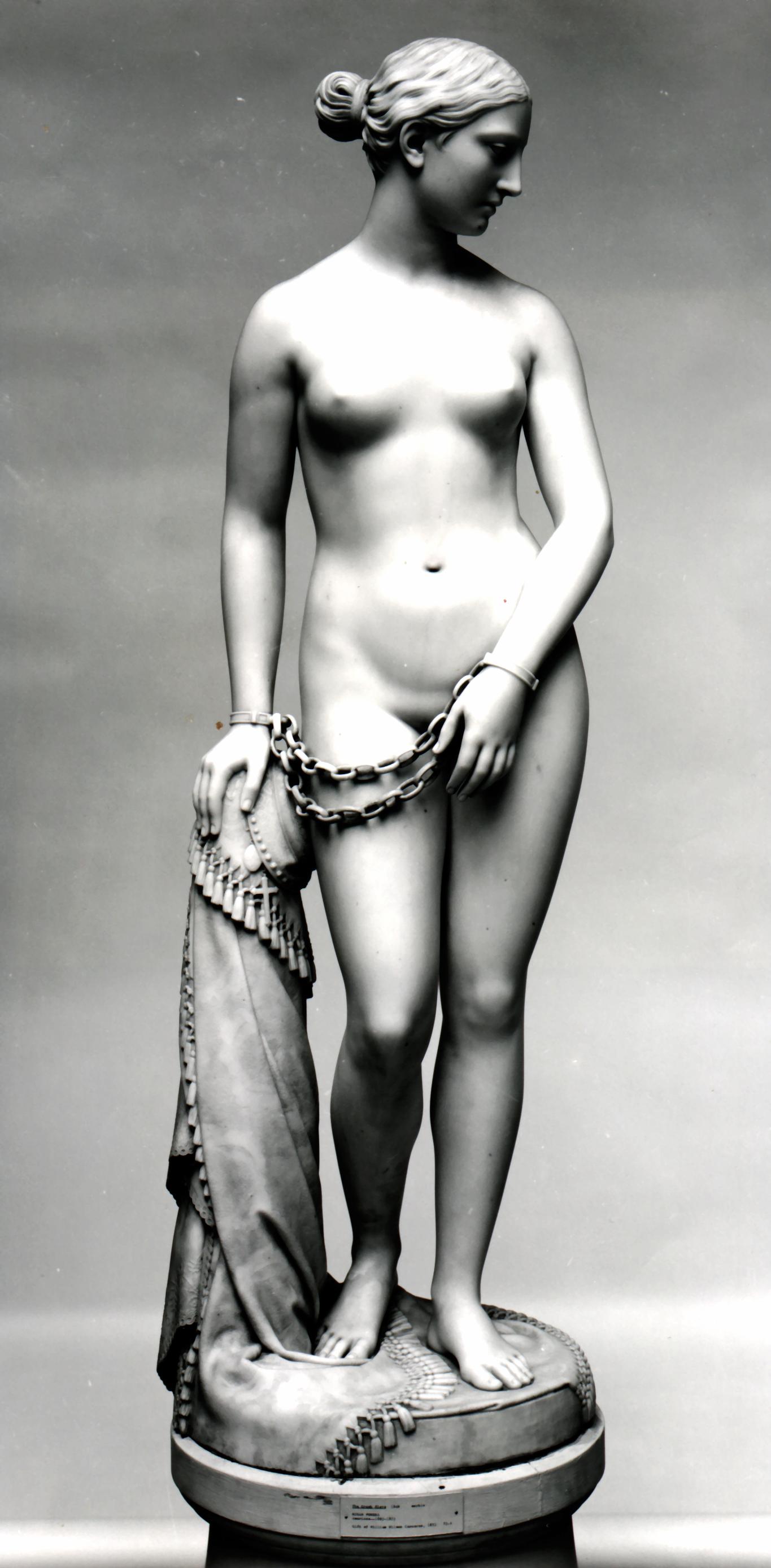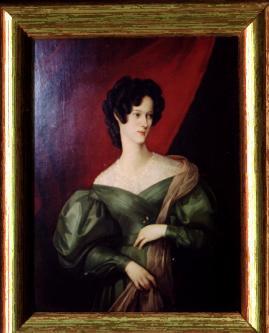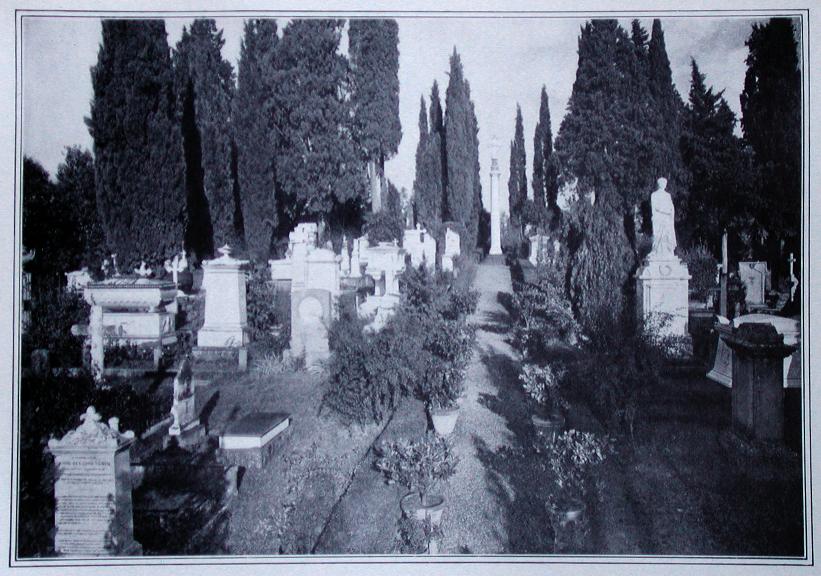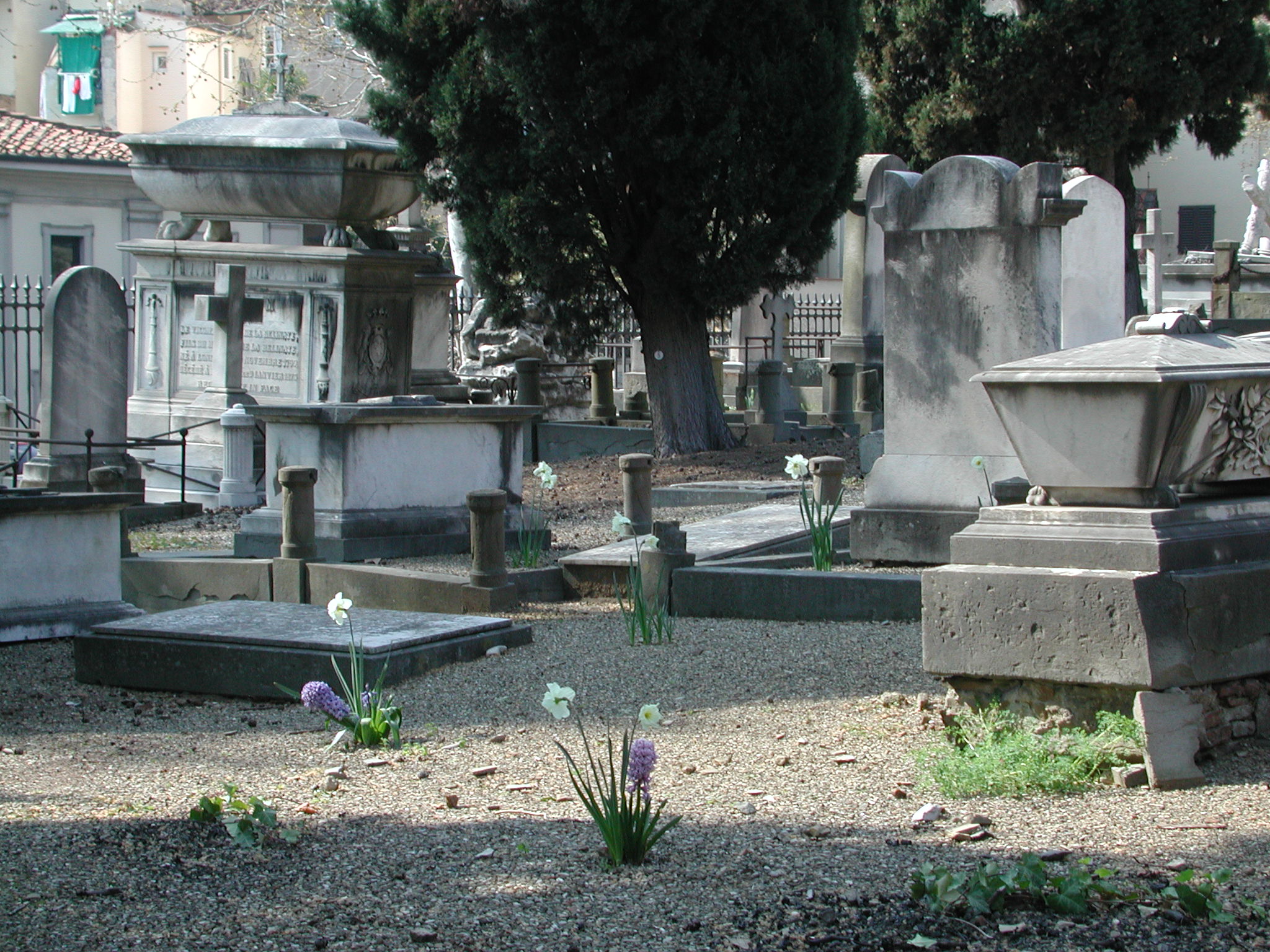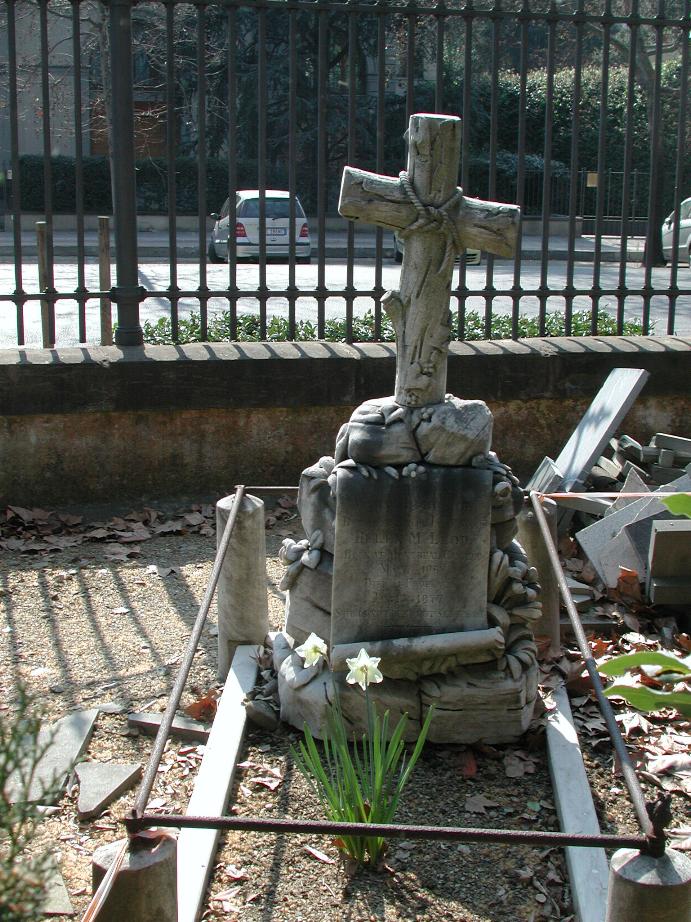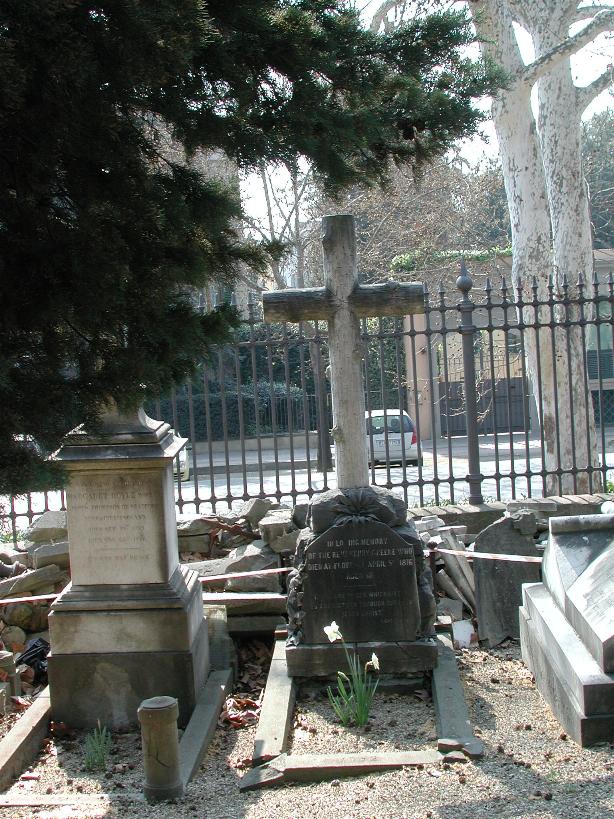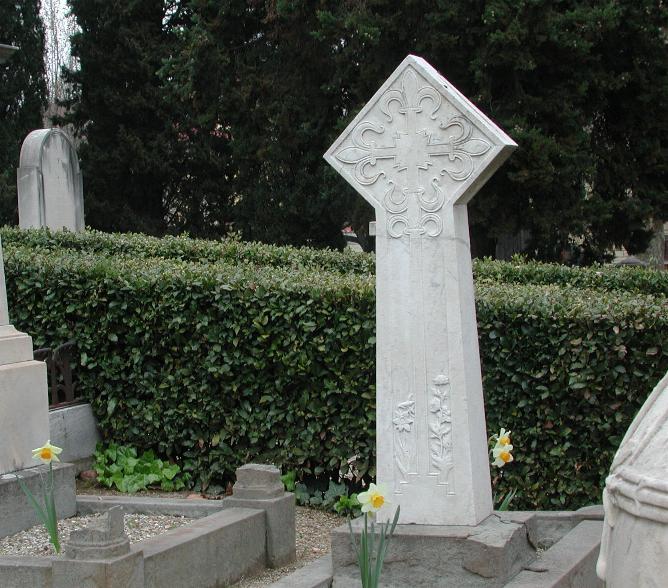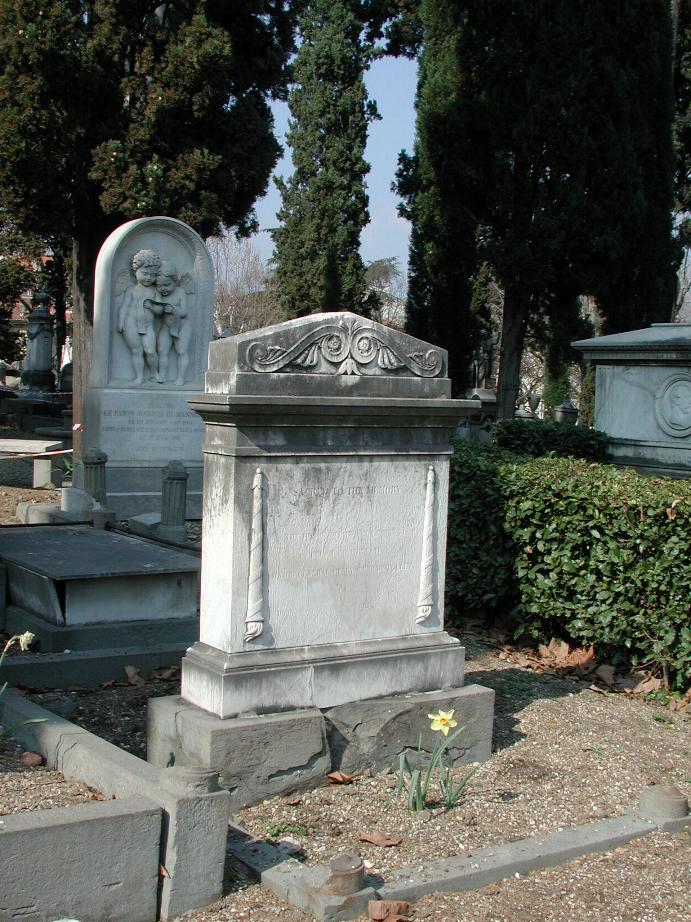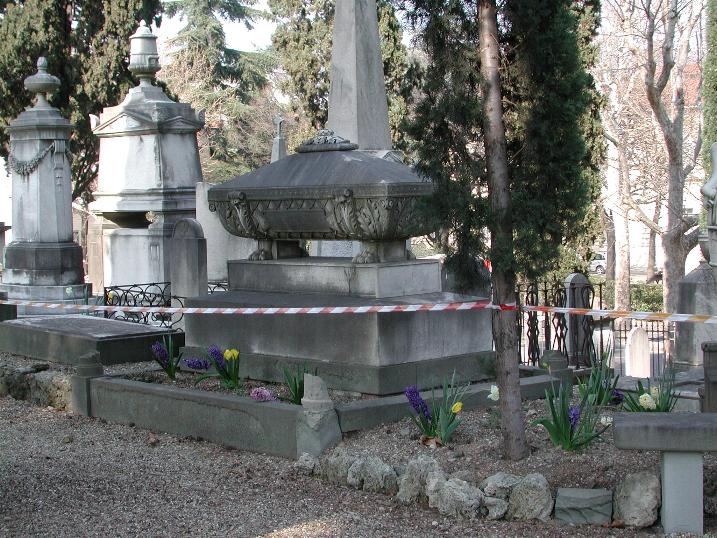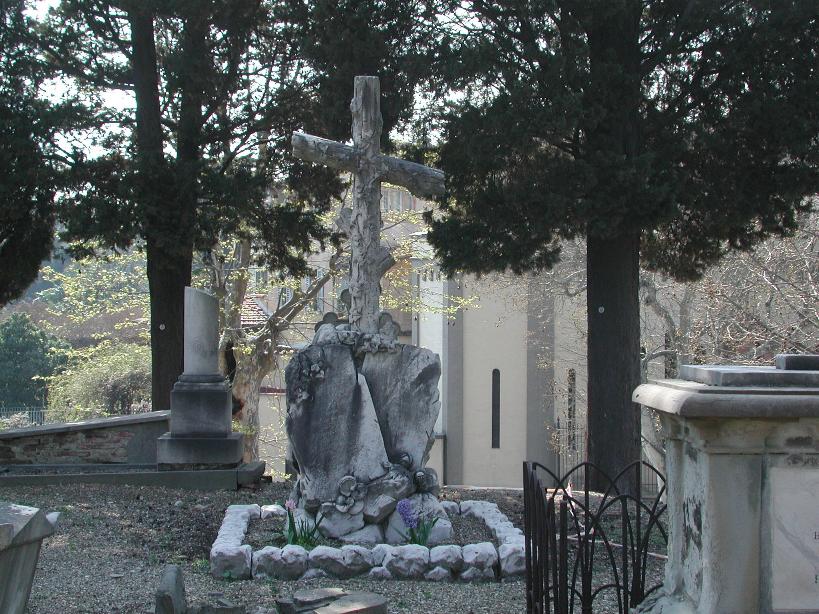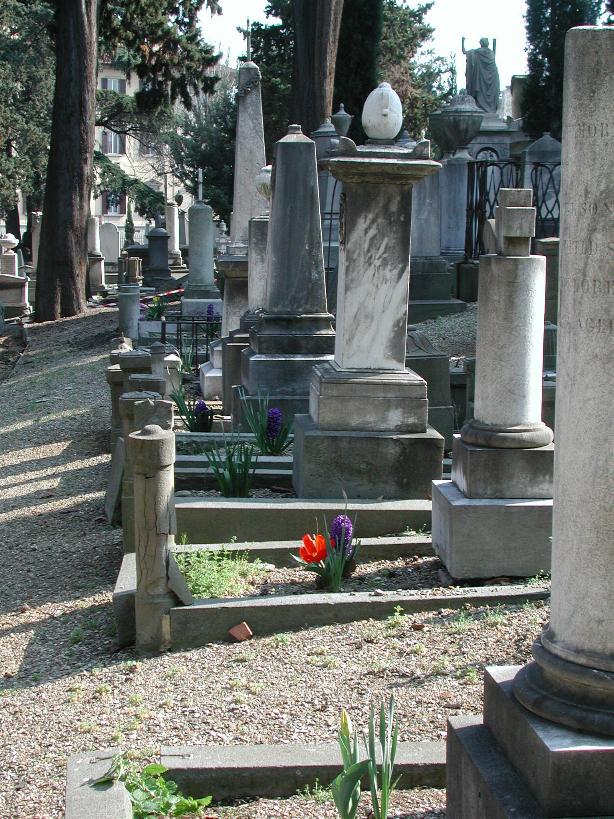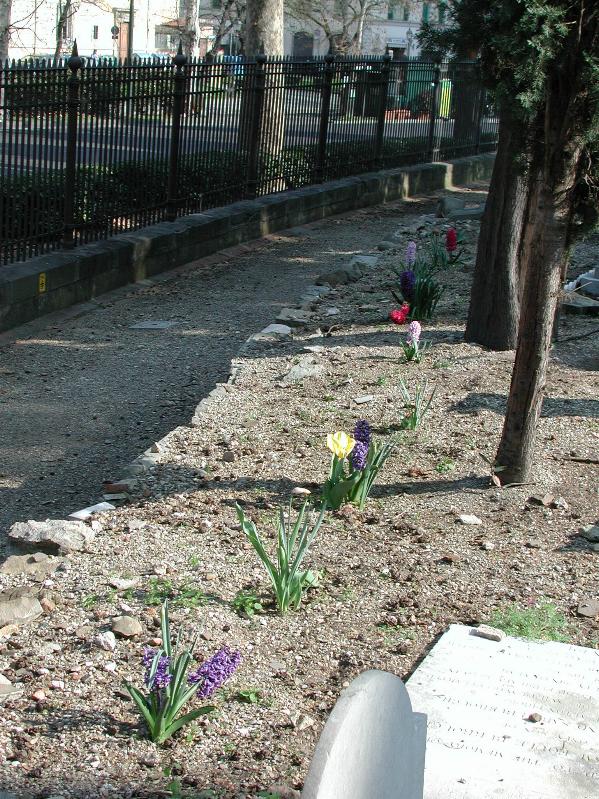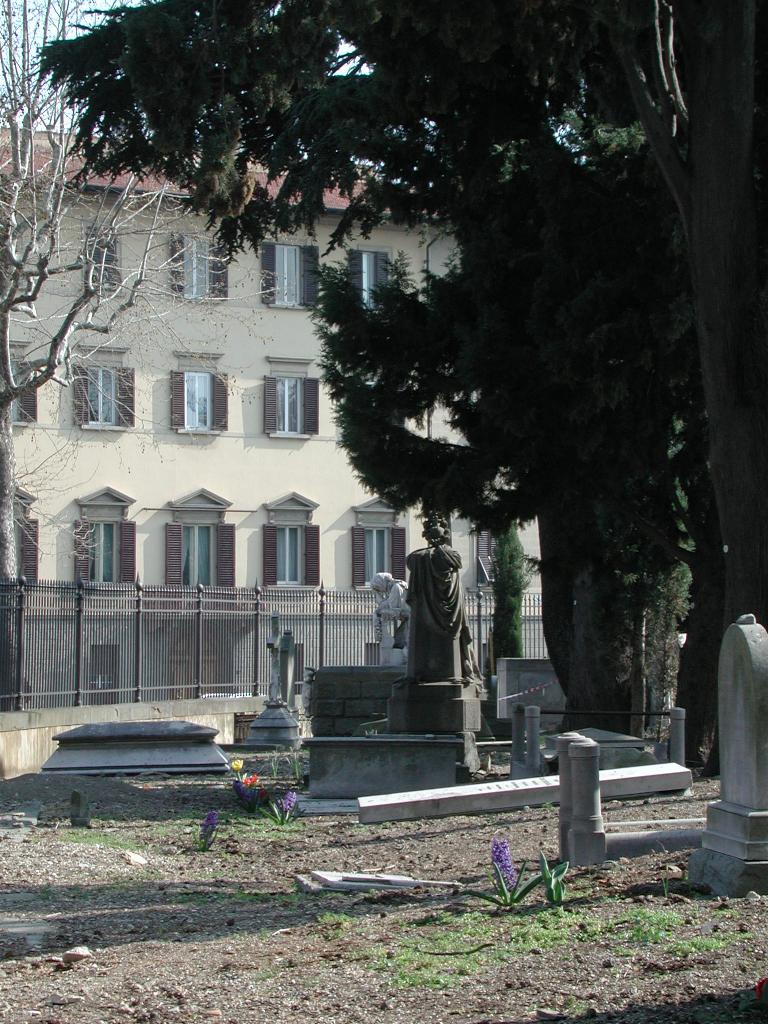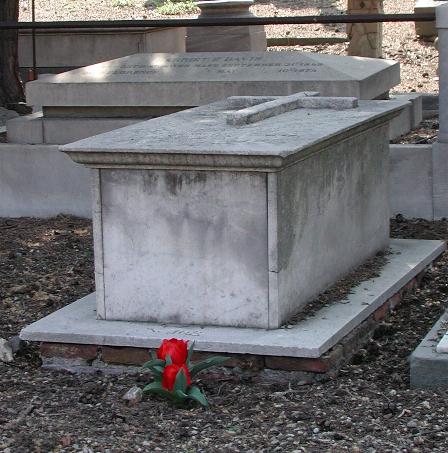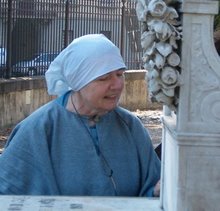Cimitero ‘degli Inglesi’, 13 Ottobre 2007
The Savage Landor Family and the Swiss-owned so-called 'English' Cemetery

Musica: Canone di Pachelbel
Flauto, Clarissa Bencini; Flauto e ottavino, Laura Manescalchi
Lettori: Julia Bolton Holloway, Presidente, Aureo Anello Associazione Biblioteca e Bottega Fioretta Mazzei; Maria Grazia Beverini Dal Santo, Presidente, Lyceum Club e Fondazione il Fiore
I. Walter Savage Landor
Walter Savage Landor loved gardens. Both Walter Savage Landor and Elizabeth Barrett Browning loved poetry and loved gardens. Seven years ago here all was dead, grey, ugly, from weed-killer. The more I read and the more I listened I learned that this so-called ‘English’ Cemetery had been a famous and most lovely garden. In Ireland once I saw a poetry garden. This hill can again become such a garden for poets and for ourselves. Now, thanks to Katherine Goldsmith of
The Ecologist and to Dott. Vieri Torrigiani Malaspina of the Giardino Torrigiani, the wild strawberries have returned, the box hedge is restored and three pomegranates grace our three famous poets’ graves. In a sense gardens and poems are human constructs married to nature, not violating her but seeking instead to heal and woo her into loveliness, into gracefulness, into fruitfulness.
Walter Savage Landor amava i giardini. Walter Savage Landor ed Elizabeth Barrett Browning, ambedue poeti, amavano la poesia e i giardini. Sette anni fa questo luogo appariva spoglio, brullo, brutto per il continuo utilizzo di sostanze diserbanti. Da numerosi diari e documenti apprendiamo che questo Cimitero detto ‘degli Inglesi” era un famoso e bellissimo giardino. In Irlanda ho potuto ammirare un giardino della poesia, e questa collinetta potrebbe trasformarsi in uno splendido parco dei poeti per tutti noi. Ora grazie alla generosità di Katherine Goldsmith, moglie del fondatore ed editore di
The Ecologist, e grazie al Dott. Vieri Torrigiani Malaspina del Giardino Torrigiani, sono state create delle siepi di bosso e sono stati piantati tre piccoli melograni che adornano i sepolcri dei nostri illustri poeti, cominciano anche a spuntare le piantine di fragole di bosco così come un tempo. In un certo senso i giardini e la poesia sono creazione dell’uomo intimamente legati alla natura, non la violano ma cercano invece di sanarla e corteggiarla per esaltarne la bellezza, la fecondità e la grazia.
Walter Savage Landor (1775-1864) is the poets’ poet, beloved by the Shelleys and the Brownings. He was impetuous, generous and difficult, a Romantic writer who had outlived that famous poetic generation of Keats, Shelley and Byron. He was born in Warwick, educated at Rugby and Trinity, and published
Gebir at twenty-three, then again in 1803 in both English and in Latin. The idea for the Arabian tale of
Gebir, set in Egypt, came from a book Rose Aylmer, the daughter of Lord Aylmer, had lent him.
Gebir was Shelley’s favourite poem. It was also admired by Southey. In 1799 the young and beloved Rose Aylmer sailed for Bengal with her aunt, Lady Russell, dying there of cholera.
Walter Savage Landor (1775-1864), il poeta dei poeti, fu molto amato dai Shelley e dai Browning. Di temperamento impetuoso, spirito ribelle ma al contempo generoso, poeta romantico che sopravvisse all’illustre generazione di Keats, Shelley e Byron. Nasce a Warwick e compie gli studi alla Rugby School e al Trinity College. Pubblica ventitreenne il poema epico
Gebir, che ripubblica poi nuovamente nel 1803 in inglese e in latino. L’idea per il racconto arabo di
Gebir gli derivò da un libro avuto in prestito da Rose Aylmer, figlia di Lord Aylmer.
Gebir fu il poema più amato da Shelley e grandemente apprezzato da Robert Southey. Nel 1799 la giovane e amata Rose Aylmer compie un viaggio con la zia Lady Russell in Bengala e muore lì di colera.
Fighting at his own expense in Spain against Napoleon provided Savage Landor material for
Count Julian. In 1811 he met Julia Thuillier, the daughter of a bankrupt Swiss banker, at a dance in Bath and immediately married her. They came to Florence in 1821, following a time in Wales. Here he acquired the Villa Gherardesca in San Domenico, now the Scuola di Musica di Fiesole and began the
Imaginary Conversations. In his poetry he is feminist, especially his
Pericles and Aspasia. But in 1835 he separated from his wife and children, though writing poems to his daughter Julia and his son Arnold. There is a lovely portrait by Trajan Wallis of Julia and her daughter and son. Trajan Wallis also erected the tomb for his father, likewise a painter, here. Walter Savage Landor returned to Florence in 1858 only to be rejected by his family, the Brownings befriending him in his last years from their love for his poetry. The young American Kate Field adored him. Algernon Charles Swinburne visited him admiringly, then wrote the epitaph quoted on his humble grave. It is his widow Julia Savage Landor’s statue by the Sicilian Michele Auteri Pomar that we saw on the tomb of their eldest son, Arnold Savage Landor, though she is buried in the Allori Cemetery. Present with us today are the widow of Dr John Landor, Professor Mary Landor, and the descendants of Julia’s Julia’s Julia, the Conti Negroni Bentivoglio of Modena and Vercelli.

Now at the statue’s base

lie the remains of the great poet’s son Walter Savage Landor II, the grandson, A. Henry Savage Landor, and Dr John Landor, likewise a descendant, the poet’s family reconciled within this ‘English’ Cemetery’s beautiful oval.


Per il dramma in versi
Count Julian (
Conte Julian) trasse ispirazione dalla sua esperienza in Spagna dove combattè con le sue proprie risorse contro Napoleone. Nel 1811 conosce ad un ballo Julia Thuillier, figlia di un banchiere svizzero finito in bancarotta e subito la sposa. Essi giungono a Firenze nel 1821, dopo un periodo trascorso in Galles. A San Domenico di Fiesole acquista la Villa Gherardesca, ora Scuola di Musica di Fiesole ed inizia a scrivere
Imaginary Conversations (Conversazioni immaginarie). Nella sua poesia si rivela un poeta femminista, in particolare ciò si coglie nel suo
Pericles and Aspasia (
Pericle e Aspasia). Separatosi dalla moglie e dai figli nel 1835 continua tuttavia a scrivere poesie che dedica ed invia alla figlia Julia e al figlio Arnold. Un bellissimo dipinto ad olio, opera di Trajan Wallis, ritrae Julia Savage Landor con la figlia Julia ed il figlio Arnold. Il padre di Trajan Wallis, anch’egli pittore, ha trovato sepoltura in questo cimitero. Walter Savage Landor ritornò a Firenze nel 1858 ma subì il rifiuto da parte della sua famiglia. I Browning che amarono profondamente la sua poesia e a lui furono legati da profonda amicizia lo soccorsero negli ultimi difficili anni della sua vita. Algernon Charles Swinburne pieno di ammirazione giunse a Firenze in visita e scrisse per lui il bellissimo epitaffio che oggi possiamo leggere sulla sua umile tomba. Sulla tomba di Arnold Savage Landor, figlio primogenito del poeta, anch’egli qui sepolto, ammiriamo la statua della madre Julia Savage Landor, opera dello scultore palermitano Michele Auteri Pomar, ma Julia Savage Landor riposa al Cimitero ‘agli Allori’. Siamo lieti della presenza a questa cerimonia di numerosi discendenti di Walter Savage Landor e Julia Savage Landor. Ai piedi di questo monumento riposano ora il secondogenito di Walter Savage Landor, che porta il suo stesso nome, il nipote A. Henry Savage Landor e il Dottor John Landor. La famiglia del poeta è qui riconciliata nell’ovale del bellissimo Cimitero ‘degli Inglesi’.
Musica: Adagio dalla VI Sonata del Pastor Fido di Vivaldi
This passage in
Gebir where the sea-nymph offers a reward was admired by all, especially the poet Shelley.
But I have sinuous shells, of pearly hue
Within, and they that lustre have imbibed
In the sun's palace porch, where when unyoked
His chariot-wheel stands midway in the wave;
Shake one and it awakens, then apply
Its polisht lips to your attentive ear,
And it remembers its august abodes,
And murmurs as the ocean there.
Il passo in
Gebir dove la nereide offre in dono delle conchiglie al pastore Tamar è un passo da tutti ammirato, in particolare da Shelley.
Ho conchiglie a spirale, dal cuore
di perla, imbevute del bagliore di luce
Nel portico del palazzo del sole, dove staccata dal giogo
La ruota del suo cocchio
Riposa a metà nell’onda;
Scuoti una conchiglia e si desta, avvicina
I lucenti suoi bordi al sollecito tuo orecchio,
Ricorda essa le auguste sue dimore,
E come l’oceano mormora.
Walter Savage Landor strongly defended the Florentine couple who became Protestant, Francesco and Rosa Madiai, writing his last
Imaginary Conversation about their imprisonment. Their crime, reading the Bible in Italian. Rosa Madiai is buried beside the tomb of Arnold Savage Landor.
Walter Savage Landor difese con forza Francesco e Rosa Madiai che si convertirono al protestantesimo e scrisse di loro e della loro condanna al carcere nella sua ultima
Imaginary Conversation. Il loro crimine fu quello di aver letto la Bibbia in italiano. Rosa Madiai riposa accanto al sepolcro di Arnold Savage Landor.
Walter Savage Landor’s quatrains are exquisite.
In 1909 the lines of his poem on Rose Aylmer were placed on her tomb in Calcutta.
Ah what avails the sceptred race,
Ah what the form divine!
What every virtue, every grace!
Rose Aylmer, all were thine.
Rose Aylmer, whom these wakeful eyes
May weep, but never see,
A night of memories and of sighs
I consecrate to thee.
Le quartine di Walter Savage Landor sono mirabili.
Nel 1909 i versi che il poeta compose nel 1799 per la sua musa Rose Aylmer sono stati posti come epitaffio sulla tomba di lei a Calcutta.
Ah, a cosa serve la razza imperiale,
La divina forma!
Ogni virtù e grazia!
Tutto ciò era in te, Rose Aylmer.
Questi occhi che ti vegliano, Rose Aylmer,
Possono piangerti ma non vederti.
Una notte consacro a te
Di memorie e sospiri.
And this one my favourite:
Death stands above me, whispering low
I know not what into my ear:
Of his strange language all I know
Is there is not a word of fear.
E questa quartina è la mia favorita.
Aleggia su di me la morte, bisbiglia lieve
Non so cosa al mio orecchio:
Della sua lingua straniera tutto ciò che so
E’ che non c’è una parola di paura.
Musica: Sarabanda di J. S. Bach
II. The Writers: Their Books, Their Tombs
We celebrate today 180 years of the existence of this cemetery and its first burial, of the fifteen year old son of the Swiss Pastor, Jean David Marc Gonin. Signor Gerardo Kraft, President of the Swiss Evangelical Reformed Church, will carry to his tomb his portrait, sent to us by the family’s descendants in Paris. Piero Bazzanti has made him as if eighteen on his tomb, the portrait by Solomon Counis, also buried here, makes him as if twenty-two.
II. Gli scrittori: i loro libri, i loro sepolcri
Oggi ricordiamo e celebriamo anche il 180° anniversario dell’istituzione del Cimitero Porta a’ Pinti detto “degli Inglesi”. Jean David Marc Gonin, primogenito quindicenne del Pastore svizzero Jean Pierre Gonin, fu il primo a trovare sepoltura in questo cimitero. La sua tomba fu eseguita nella bottega di Piero Bazzanti. Il Signor Gerardo Kraft, Presidente della Chiesa Evangelica Riformata Svizzera, porterà alla sua tomba una foto del ritratto di lui, dono dei discendenti che vivono a Parigi. Il monumento di Piero Bazzanti lo rappresenta diciottenne, il ritratto di lui ventiduenne è opera di Solomon Counis. Anch’egli riposa in questo cimitero.
Tombs and paintings, poems and books, outlast our mortal bodies, carrying memories that converse with the future, across centuries. They tell stories. They are the
Greek Anthology, they are Edgar Lee Master’s
Spoon River Anthology, but giving the story of Florence and her foreigners, rather than of St Louis and her Americans, of Athens and her citizens and slaves.
Le tombe e i libri sopravvivono a noi fatti di involucro mortale, sono memoria che conversa con il tempo futuro lungo i secoli. Sono l’
Antologia palatina, sono l’
Antologia di Spoon River. Gli epitaffi raccontano la storia di Firenze e degli stranieri che nell’Ottocento elessero l’amata città a loro dimora.
To honour our poets, our writers, we now will bring their books to their tombs. I will hand to persons books who will at the end of this discourse carry them to the respective tombs, reading there the title page of one of them and perhaps a selection, next bringing them to the back room of the library where we will place them in display cases for all to see.
Per rendere omaggio ad alcuni degli scrittori che qui hanno trovato sepoltura consegno ad alcuni di voi dei volumi da porre sui loro sepolcri. Ognuno di voi leggerà il frontespizio di uno dei libri di ciascun autore.
Musica: Danza ungherese di Brahms
WALTER SAVAGE LANDOR
On Walter Savage Landor’s newly-restored tomb are written Swinburne’s lines:
La tomba di Walter Savage Landor è stata recentemente restaurata. Swinburne compose il suo epitaffio.
IN MEMORY OF/ WALTER SAVAGE LANDOR/ BORN 30th OF JANUARY 1775/ DIED 17th OF SEPTEMBER 1864/ AND THOU HIS FLORENCE TO THY TRUST/ RECEIVE AND KEEP/ KEEP SAFE HIS DEDICATED DUST/ HIS SACRED SLEEP/ SO SHALL THY LOVERS COME FROM FAR/ MIX WITH THY NAME/ MORNING STAR WITH EVENING STAR/ HIS FAULTLESS FAME/ A.G. SWINBURNE/
IN MEMORIA DI WALTER SAVAGE LANDOR NATO IL 30 GENNAIO 1775 MORTO IL 17 SETTEMBRE 1864 – E TU LA SUA FIRENZE CURA, ACCOGLI, SERBA LA SUA DONATA POLVERE, IL SUO SACRO SONNO. DA LONTANO GIUNGANO I TUOI AMANTI PER CONFONDERSI CON IL NOME TUO, FIRENZE, E LA PURA FAMA DI LUI COSI’ COME LA STELLA DEL MATTINO CON LA STELLA DEL VESPRO. A. C. SWINBURNE
Count General Negroni Bentivoglio, descendant of Walter Savage Landor, will carry the books to his tomb. Pastore Mario Marziale, of the Swiss Evangelical Reformed Church, instead, will carry the volume with the Imaginary Conversation about Rosa Madiai to her tomb. The Madiai’s imprisonment was because, as Italians, they were forbidden to read the Bible. In this Protestant Cemetery countless tombs quote from the Bible in many alphabets and numerous languages. This is the place of the Book and of Freedom.
Il Conte Generale Negroni Bentivoglio, discendente della famiglia Savage Landor, porrà i suoi libri sulla sua tomba. Il Pastore Mario Marziale della Chiesa Evangelica Riformata Svizzera, porrà sulla tomba di Rosa Madiai uno dei volumi di Imaginary Conversations. I Madiai subirono l’umiliazione della condanna e del carcere perché come italiani era loro proibito leggere la Bibbia. In questo Cimitero Protestante innumerevoli iscrizioni sepolcrali citano passi tratti dalla Bibbia in molti alfabeti e diverse lingue. E’ un luogo della memoria, del Libro dei libri, e della libertà.
ELIZABETH BARRETT BROWNING
Elizabeth Barrett Browning’s tomb, however, lacks her name, her birth date, her poetry, her portrait, only giving her initials, her death date, and the sculptor’s name who executed the similarly anonymous design of Frederic Lord Leighton. Leighton insisted on a broken slave shackle being placed on the tomb to honour Elizabeth’s poetry against slavery.
Sulla tomba di Elizabeth Barrett Browning manca il suo nome, manca la data di nascita e la sua effige. Possiamo leggere solo le sue iniziali EBB, la data di morte, e il nome dello scultore che esegui il sarcofago su disegno di Frederic Lord Leighton, anch’egli anonimo. Leighton volle sulla tomba della poetessa una catena spezzata in omaggio alla sua poesia che porta il segno del suo grande disprezzo per ogni forma di schiavitù.
E.B.B./ OB.1861.// FRANCESCO GIOVANNOZZI FECE.
Maria Grazia Beverini Del Santo, President of the Lyceum Club and of the Fondazione il Fiore, will carry to Elizabeth’s newly-restored tomb her books, especially the Sonnets from the Portuguese translated into countless other languages, and her epic poem in nine books,
Aurora Leigh.
Io porterò i suoi libri sul suo sepolcro restaurato nel 2006, in particolare i suoi Sonnets from the Portuguese che sono stati tradotti in un’infinità di lingue, ed il suo poema epico in nove libri
Aurora Leigh.
ARTHUR HUGH CLOUGH
Our third great poet is Arthur Hugh Clough whose poetry was published posthumously by his wife, Blanche, Florence Nightingale’s cousin, and his sister, Anne Jemima Clough, who founded Newnham College. Like Walter Savage Landor he had gone to Rugby School, Matthew Arnold composing Thyrsis for his epitaph. At Oxford Clough attended Balliol, winning the Oriel College Fellowship.
Il nostro terzo illustre poeta è Arthur Hugh Clough. La sua opera poetica è stata pubblicata postuma dalla moglie, Blanche, cugina di Florence Nightingale, e dalla sorella, Anne Jemima Clough, fondatrice del Newnham College. Così come Walter Savage Landor compì gli studi alla Rugby School. Matthew Arnold compose l’elegia Thyrsis in memoria dell’amico. Ad Oxford frequentò il Balliol College, e fu Fellow dell’Oriel College.
ARTHUR HUGH CLOUGH/ SOMETIME FELLOVV/ OF ORIEL COLLEGE OXFORD/ DIED AT FLORENCE/ NOVEMBER 13 MDCCCLXI/ AGED 42/ THE LAST FAREVVELL OF/ HIS SORROVVING VVIFE AND SISTER/
Mark Roberts of the Harold Acton Library of the British Institute of Florence will carry the volume of his poems to his tomb. It came to us as a gift from Walter Savage Landor’s Warwick. The tomb was restored last year by the Museo Archeologico Nazionale di Firenze to celebrate European Heritage, because the design of the winged globe on the tomb, desired by Blanche Clough, was taken from Champollion’s book on Egypt and Nubia owned by the Marchese Torrigiani.
Mark Roberts della Harold Acton Library del British Institute di Firenze porrà sulla sua tomba il volume delle sue poesie, dono della Walter Savage Landor Society di Warwick. La tomba è stata restaurata lo scorso anno dal Museo Archeologico Nazionale di Firenze in occasione delle Giornate Europee del patrimonio. Il disegno del motivo egizio del disco solare alato che compare sulla tomba è stato tratto per volere di Blanche Clough dal volume di Champollion sull’Egitto e sulla Nubia posseduto dal Marchese Torrigiani.
ISA BLAGDEN
A great friend of Walter Savage Landor and of the Brownings was Isa Blagden of Bellosguardo. She, too, was a poet. And she and the poet Owen Meredith wrote books about each other, she a novel, he a poem, Owen Meredith being the pen-name for Lord Lytton, Viceroy of Indian.
Isa Blagden grande amica di Walter Savage Landor e dei Browning ospitò molti degli stranieri che giungevano a Firenze nella Villa Brichieri a Bellosguardo. Anche Isa Blagden fu poeta. Ella e il poeta Owen Meredith scrissero libri sul loro amore, Isa Blagden una autobiografia romanzata,
Agnes Tremorne, e Owen Meredith un poema,
Lucile, su di lei. Owen Meredith, pseudonimo di Lord Lytton, fu Vicerè delle Indie.
ISABELLA [Cross on Flower Garland] BLAGDEN/ BORN . . . DIED . . . 1873/ THY WILL BE DONE . . ./
Corinna Gestri will carry her volume of poems to her tomb.
Corinna Gestri porrà il volume delle sue poesie sul sepolcro.
POEMS/ BY THE LATE/ ISA BLAGDEN/ WITH A MEMOIR/ WILLIAM BLACKWOOD AND SONS/ EDINBURGH AND LONDON/ MDCCCLXXIII
FRANCES TROLLOPE
Frances Trollope was a writer of novels and of travels, and of the first anti-slave novel,
Jonathan Jefferson Whitlaw, a book no longer in print but better than Harriet Beecher Stowe’s
Uncle Tom’s Cabin. Not far from her tomb and that of Elizabeth Barrett Browning is the tomb of Nadezhda, who came at 14, a Black slave from Nubia, and whose story is told on her tomb in Cyrillic.
Frances Trollope autrice di romanzi e di letteratura di viaggio. Suo è il primo romanzo contro la schiavitù
Jonathan Jefferson Whitlaw, un libro ormai fuori stampa ma più degno di nota di
Uncle Tom’s Cabin (La Capanna di Zio Tom) di Harriet Beecher Stow. Non lontano dalla sua tomba e dal sarcofago di Elizabeth Barrett Browning troviamo la tomba di Nadezhda, una schiava nera che giunse a Firenze dalla Nubia a quattordici anni d’età. La sua storia è narrata in cirillico sul basamento della bellissima croce russa.
FRANCESCAE TROLLOPE/ QUOD MORTALE FUIT/ HIC IACET/ . . . / MEMORIA/ NULLUM MARMOR QUAERIT/ APUD STAPLETON/ IN AGRO SOMERSET ANGLORUM/ A.D. 1780 NATA/ FLORENTIAE/ TUMULUM A.D.1863/ NACTA EST
Debora Spini of Syracuse University will carry her anti-slavery novel,
Jonathan Jefferson Whitlaw, to her tomb.
Debora Spini della Syracuse University porrà il romanzo
Jonathan Jefferson Whitlaw sulla sua tomba.
THEODOSIA TROLLOPE
Theodosia Garrow Trollope, Frances’ daughter-in-law, and like Isa, part Jewish, part East Indian, wrote poetry, essays, translations.
Theodosia Garrow Trollope, nuora di Frances Trollope, e come Isa Blagden, in parte ebrea, e in parte le sue origini sono da ricercare nelle Indie Orientali, scrisse poesia, saggi, e tradusse dall’italiano in inglese.
/ THEODOSIAE TROLLOPE/ T. ADOLFI TROLLOPE CONIUGIS/ QUOD MORTALE FUIT/ HIC IACET/ OBITUM EIUS FLEVERUNT OMNES/ QUANTUM AUTEM FERRI MERUIT/ VIR EUGUI SCRIPTORES/ SCIT SOLUS/ JOSEFE GARROW ARMr FILIA/ APUD TORQEW IN AGRORUM DEVON ANGLORUM NATA/ FLORENTIAE NOMEN AGENS LUSTRUM/ AD PLURES DIVINAE . . ./ MENSES APRILES A.D. 1865/
Lacking any of her books Alyson Price will take to her tomb her husband Thomas Adolphus Trollope’s autobiography,
What I Remember - where he remembers her.
Non abbiamo alcun volume dei suoi libri e Alyson Price le renderà omaggio ponendo sulla sua tomba l’autobiografia
What I Remember del marito Thomas Adolphus Trollope, dove egli la ricorda.
MARY SOMERVILLE
A great woman writer of science, Mary Somerville, buried her husband William here, and in her honour we have just now restored his tomb.
Grande scrittrice di testi scientifici, brillante astronoma e matematica, Mary Somerville, diede qui sepoltura al marito, William. Per rendere omaggio a lei è stato restaurato il bellissimo sepolcro del marito.
WILLIAM SOMERVILLE/ ELDEST SON OF THE HISTORIAN OF QUEEN ANNE/ BORN AT MINTO ROXBURGHSHIRE/ 22 APRIL 1771/ DIED AT FLORENCE 15 JUNE 1860/ GOD WILL REDEEM MY LIFE FROM/ THE POWER OF THE GRAVE 49 PSALM/
Mary Somerville herself is buried in Naples beneath a fine statue of her by the then twenty-year-old Calabrian Francesco Jerace. She had discovered two planets and taught Ada Lovelace, Lord Byron’s daughter, mathematics. Ada, then, with Charles Babbage, invented the computer, she suggesting to him the use of Jacquard loom cards with holes punched in them and the binomial theorem.
Mary Somerville ha trovato invece sepoltura a Napoli sotto la statua che la rappresenta, opera giovanile dello scultore calabrese Francesco Jerace. Mary Somerville scoprì due pianeti ed insegnò matematica ad Ada Lovelace, figlia di Lord Byron. Successivamente Ada e Charles Babbage idearono il computer. Fu lei a suggerire l’utilizzo delle schede perforate del telaio Jacquard e del sistema numerico binario.
Lyn Newton from Scotland will carry two of her many books to her husband’s grave.
Lyn Newton, scozzese, per rendere a lei omaggio porrà due dei suoi numerosi libri sulla tomba del marito.
ON/ THE CONNEXION/ OF THE PHYSICAL SCIENCES/ BY MARY SOMERVILLE/ FOURTH EDITION/ LONDON:/ JOHN MURRAY, ALBERMARLE STREET/ MDCCCXXXVI
PERSONAL RECOLLECTIONS, From Early Life to Old Age,/ OF/ MARY SOMERVILLE,/ WITH SELECTIONS FROM HER CORRESPONDENCE,/ BY HER DAUGHTER,/ MARTHA SOMERVILLE/ BOSTON:/ ROBERTS BROTHERS,/ 1874
MARY YOUNG
Another woman writer, this time of religious history, buried here, is Mary Young.
Ha qui inoltre trovato sepoltura Mary Young, anch’essa scrittrice, autrice della biografia su Aonio Paleario, umanista e riformatore religioso.
HOLD [Anchor] FAST/ TO THE MEMORY OF/ MARY YOUNG/ DAUGHTER OF THE LATE/ JOHN STROTHER ANCRUM OF ROXBURGH/ AND WIDOW OF THE REV. ROBERT YOUNG DD MINISTER OF THE/ SCOTS CHURCH LONDON WALL/ ENDOWED WITH SUPERIOR AND REFINED INTELLECT/ FIRM CHARACTER AND ARDENT AFFECTIONS/ SHE WAS BY GOD'S GRACE ENABLED TO SPEND HER WHOLE LIFE IN HIS SERVICE/ AND IN SE. . E . .ING EFFORTS FOR THE GOOD OF OTHERS/ HER FAITH WAS SIMPLE AND UNWAVERING/ SUPPORTED BY THIS FAITH AND CHEERED BY THE HOPE OF GLORY/ SHE ENDURED WITH FORTITUDE THE DECAY OF HER EARTHLY/ TABERNACLE AND JOYFULLY WELCOMED THE SUMMONS/ WHICH CALLED HER HENCE/ ON THE 27 DAY OF SEP 1867/ AGED 77/ AMEN. SO LET IT BE [Books and Palms]/
Il monumento reca anche un’iscrizione sepolcrale in italiano.
On the other side.
/ QUI RIPOSANO LE SPOGLIE MORTALI/ DI / MARIA YOUNG/ VISSE MOLTI ANNI IN ITALIA/ RACCOLSE NEGLI ARCHIVI NOTIZIE STORICHE/ CON CUI COMPOSE UN LIBRO ASSAI STIMATO/ LA VITA DI AONIO PALEARIO E I SUOI TEMPI/ DIMORO’ LONGAMENTE IN PISA DOVE EDIFICO’/ UNA CHIESA EVANGELICA E UNA SCUOLA/ SOCCORSE SEMPRE I POVERI AMO’ LO STUDIO E SI/ . . SE PER IL RISORGIMENTO DELLA LIBERTA’ ITALIANA/ MORIVA IN FIRENZE ALL'ETA’ DI 77 ANNI/ IL 27 SETTEMBRE 1867/ FRA LE BRACCIA DELLA INCONSOLABILE FIGLIA/ ALLA SUA CARA MEMORIA CONSACRONO QUESTA PIETRA/ CARLO E ROBINIA MATTEUCCI/
D.D. Ramsden will carry to her tomb a volume of the book she wrote.
D.D. Ramsden porrà sulla sua tomba un solo volume di questa opera.
THE LIFE AND TIMES/ OF/ AONIO PALEARIO/ OR A HISTORY OF/ THE ITALIAN REFORMERS IN THE SIXTEENTH CENTURY/ PRESENTED BY ORIGINAL LETTERS AND UNEDITED DOCUMENTS/ BY M. YOUNG/ “Their blood is shed/ In confirmation of the noblest claim,/ Our claim to feed upon immortal truth,/ to walk with God, to be divinely free,/ To soar, and to anticipate the skies”/ COWPER’S/ Task./ LONDON/ BELL AND DALDU, 186 FLEET STREET./ 1860
THOMAS SOUTHWOOD SMITH
Southwood Smith with Lord Ashley, who became the Earl of Shaftsbury, wrote against slavery and against the abuse of women and children in mines and factories, their Report changing England’s laws.
Southwood Smith e Lord Ashley, poi Conte di Shaftsbury, nei loro scritti si espressero fermamente contro la schiavitù e lo sfruttamento delle donne e dei bambini nelle fabbriche e nelle miniere. Il loro lavoro fu determinante e portò ad una riforma delle leggi in Inghilterra.
In Memory of SOUTHWOOD SMITH, Physician/ who through the promotion of sanitary/ reform in the principles of which he was the first to discover and through other philanthropic and literary labour was distinguished as a Benefactor of Mankind/ Born at Martock, Somersetshire/ Dec 21, 1788, Died at Florence/ Dec 10, 1861// + THEN SHALL THE RIGHTEOUS SHINE FORTH AS THE SUN IN THE KINGDOM/ OF THEIR FATHER/ MATTHEW XII v.43// [Below sculpted portrait medallion] / Ages shall honor, in their hearts enshrined, thee, SOUTHWOOD SMITH, Physician of Mankind/ Bringer of Air, Light, Health into the home/ Of the rich Poor of happier years to come/ Leigh Hunt/
aa a
Elizabeth Barrett Browning with Richard Horne wrote a essay on them both in
New Spirit of the Age which Giorgio Nencetti will carry to the tomb.
Elizabeth Barrett Browning e Richard Horne scrissero un saggio su di loro in
The New Spirit of the Age. Per rendere omaggio a tutti loro porteremo questo volume alla sua tomba.
ROBERT DAVIDSOHN
Robert Davidsohn, from Gdansk and Jewish, is the great historian of medieval Florence.
Robert Davidsohn, tedesco di Danzica ed ebreo, è il grande storico della Firenze medievale.
COMM. DOTT. PROF./ ROBERT DAVIDSOHN/ 26.4.1853-17.9.1937/
ROBERT DAVIDSOHN/ STORIA DI FIRENZE/ SANSONI – FIRENZE/ 1977
Alba Antuono of the Biblioteca Comunale will carry his volumes of the
Storia di Firenze to his tomb.
Alba Antuono della Biblioteca Comunale porrà i suoi volumi sulla
Storia di Firenze sulla sua tomba,
Laura Micol Fisher will carry Shakespeare’s
Plays to her great grandparents’ tomb for they are Shakespeare’s ‘last’ descendants.
Laura Micol Fisher porra il volume delle
Opere di William Shakespeare sulla tomba dei suoi bisnonni, gli ultimi discendenti di Shakespeare.
ARNOLD HENRY SAVAGE LANDOR
And Arnold Henry Savage Landor is the Florentine-born writer, painter, explorer and inventor grandson of Walter Savage Landor. We ask Piero Fusi to carry his book,
Everywhere to Henry Savage Landor’s new grave and read there its title page.
A. Henry Savage Landor, primogenito di Charles Savage Landor, e nipote del poeta Walter Savage Landor, nacque a Firenze. Dotato scrittore, pittore, esploratore, ideatore. Piero Fusi porrà il volume della sua opera autobiografica
Everywhere sulla sua nuova tomba, e li leggerà il frontespizio del libro.
EVERYWHERE/ THE MEMOIRS OF AN EXPLORER/ By A. HENRY SAVAGE-LANDOR/ ILLUSTRATED/ T.FISHER UNWIN LTD/ LONDON: ADELPHI TERRACE// I DEDICATE THIS BOOK/ TO MY SISTER/ ELFRIDA/ 1924
JOHN LANDOR
While Mary Gibbons Landor will carry the book by her husband, Dr John Landor, to his new grave in this Swiss-owned so-called ‘English’ Cemetery and read there its title page.
Mary Gibbons Landor porrà un testo del marito, Dr John Landor, sulla sua tomba e leggerà poi il frontespizio.
Elizabeth Barrett Browning’s first line to
Aurora Leigh is from the Bible. It states ‘Of writing many books there is no end’.
Il poema epico
Aurora Leigh di Elizabeth Barrett Browning si apre con queste parole bibliche ‘Di scriver libri non si vedrà mai la fine’.
Musica: Aria dal Flauto Magic







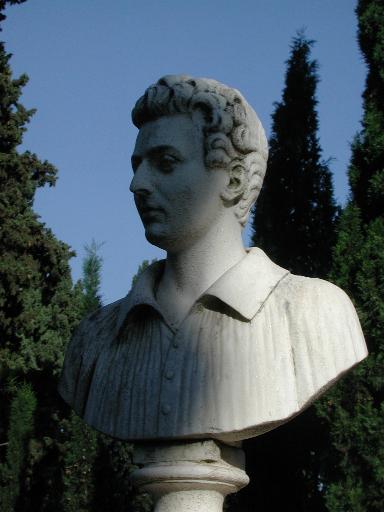



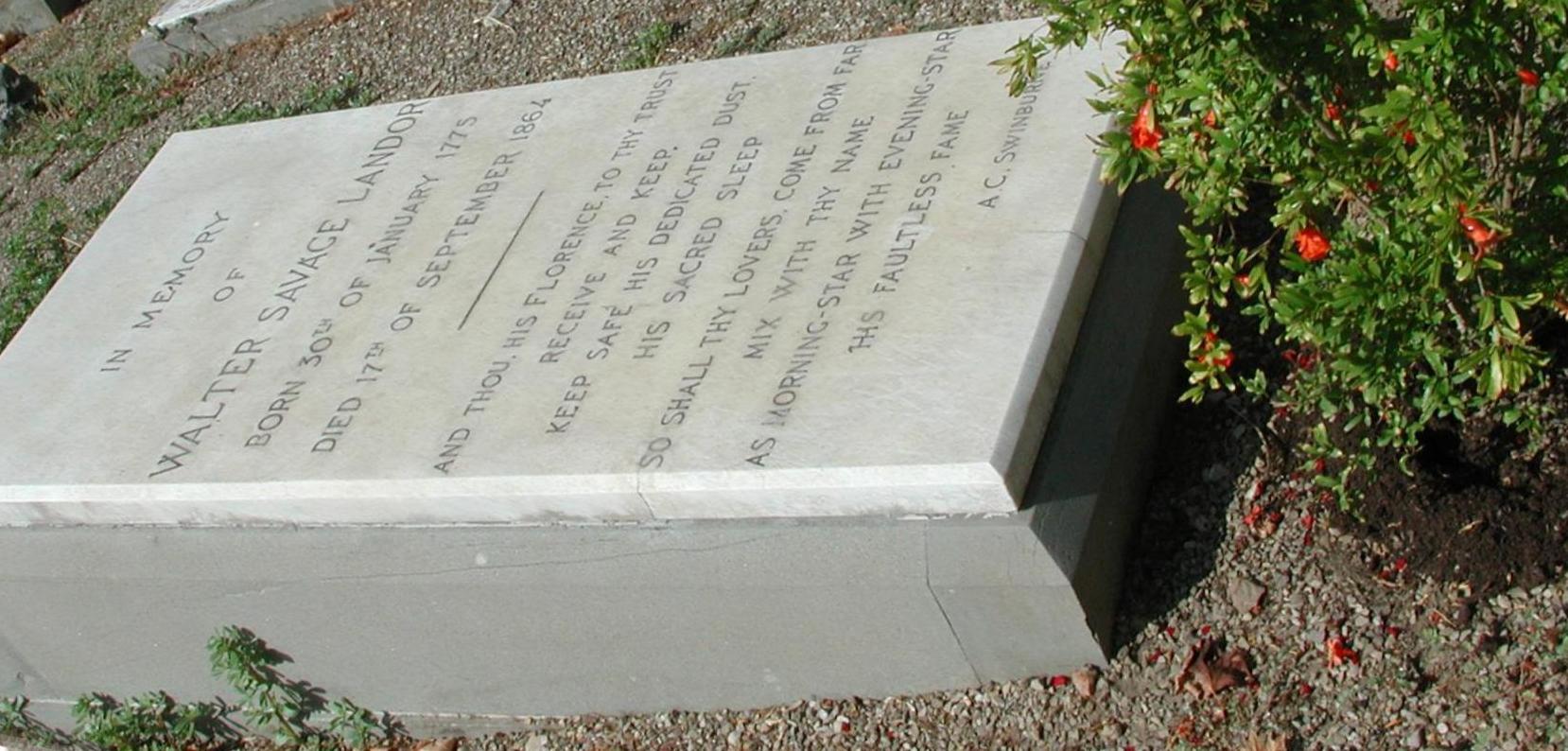 ,
,

